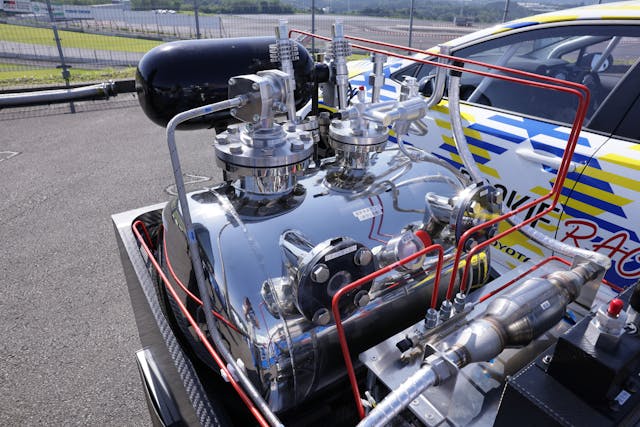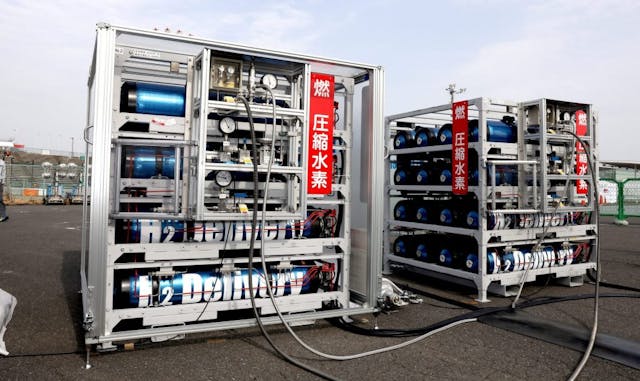Hydrogen is still in the game, but maybe not for cars
Hydrogen is the most abundant element in the universe. It powers the sun, fills the oceans and our bodies, and, when burned or forced through an electricity-generating fuel cell, sends nothing but pure, drinkable water out the tailpipe. It packs a lot of energy, too; NASA’s Artemis 1 rocket recently flew laps around the moon powered mostly by zero-emissions hydrogen. So why aren’t we driving our kids to school with it?
That’s what hydrogen proponents such as Toyota and Honda want to know as the wider industry races headlong toward battery-electric vehicles. Both automakers, as well as Hyundai, have fleets of hydrogen fuel-cell vehicles in circulation, and they are swimming against the battery-electric tide by placing even bigger bets on the odorless, colorless gas. “The whole world will not adapt at the same time [to EVs], so we need multiple solutions,” Akio Toyoda, Toyota’s chairman of the board, recently told journalists.
Mighty Toyota is the chief cheerleader for the big H. Last year, Toyota inked a deal with BMW, its partner on the Supra, to jointly develop a hydrogen fuel-cell vehicle said to be slated for 2025. It has joined heavy-duty engine-maker Cummins in exploring large engines that burn hydrogen while also collaborating with motorcycle-maker Kawasaki on mini hydrogen engines for bikes.

It all sounds promising, except for one thing: Hydrogen is not an easy fuel to work with. Though it is literally everywhere, hydrogen naturally couples up with other elements such as oxygen and carbon, meaning you must force it apart using energy. A color-coded system has been created to classify hydrogen sources by their environmental impact: Black and brown are separated from coal and are the worst; gray, the most common, is taken from methane or natural gas using energy-intensive steam reforming; blue is the same but with a carbon-capture system; and green hydrogen is separated from oxygen using electrolysis, a process that can harness renewable energy such as solar and is the cleanest of the clean, but it’s difficult to scale up and represents a tiny fraction of today’s supply.

Additionally, hydrogen is not as energy dense as gasoline or other fossil fuels, meaning you must carry a lot of it to drive very far, either packed into highly reinforced tanks at pressures of 5000 to 10,000 psi or liquefied to negative 423 degrees F. It and helium are the only gases that heat up when they expand, so leaks are potentially catastrophic. Hydrogen is the smallest molecule on the periodic table of elements and is difficult to contain, easily evaporating away through tank walls and seals. And fuel cells need much purer hydrogen than that currently produced for its most common end-use today, which is oil refining. Otherwise, the catalytic plates in fuel cells that help strip away hydrogen’s electrons to make electric current get contaminated.

There are just 56 hydrogen refueling stations in the U.S. compared with more than 50,000 EV charging stations, yet transportation thinkers say there may yet be a role for it. Heavy trucks, stationary power plants, agricultural and construction equipment, ships, and freight trains are all considered potential candidates for hydrogen conversion. Packaging storage tanks in those vehicles is less of an issue than in a family car, and the power output is greater for the weight when compared with batteries. Thus, a long-haul rig running on hydrogen can carry more payload than the same rig with the same range running on today’s batteries. And it takes much less time to refuel than to recharge a large battery pack.
As Tom Stephenson, co-founder of Pajarito Powder, a New Mexico hydrogen-components startup backed by Hyundai, told the trade publication Automotive News: “A good rule of thumb is that you’ll see hydrogen fuel cells where you see diesel today and battery electric where you see gasoline.”
***
Check out the Hagerty Media homepage so you don’t miss a single story, or better yet, bookmark it. To get our best stories delivered right to your inbox, subscribe to our newsletters.
This article first appeared in Hagerty Drivers Club magazine. Click here to subscribe and join the club.



Quite the contrary. They should eliminate all pure battery cars and convert them to hybrids with either green hydrogen or efuels. I spoke to people who own electrics and the biggest problem is the time to recharge and the significant effect on range due to cold weather.